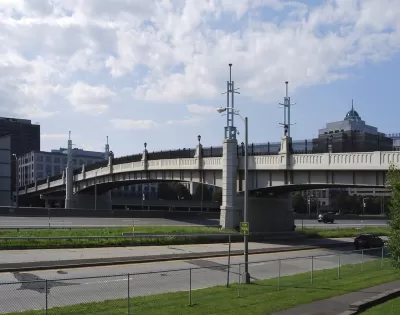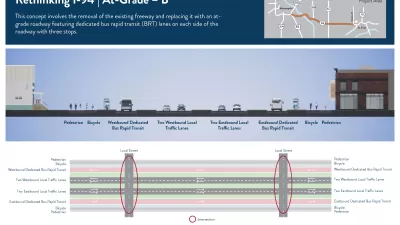Finding full-scale highway removal nearly impossible, advocates in the New York state capital turn to creative workarounds to reconnect the city to the Hudson River.

Built during the highway craze of the 1960s (which arguably continues today), the six-lane Interstate 787 in Albany lets commuters "make a swift exit to outlying suburbs or points downstate," but also blocks access to the city's waterfront on the Hudson River. Like other urban highways, writes Mike De Socio, I-787 "also devoured about 100 acres of downtown Albany, bulldozing homes and businesses, cutting the city off from the riverfront and walling off some of its poorest neighborhoods."
Yet for decades, efforts to remove parts of the highway have failed, "[s]o now the city is chasing a number of offbeat workarounds." Proposals range from an elevated, High Line-style park to "digging a canal through downtown Albany, in an effort to bring the river back into the city."
So far, the only project that has broken ground is the Albany Skyway, "an on-ramp-turned-linear-park due to open next year." According to Matthew Peter, executive director of the Albany Parking Authority and one of the driving forces behind the project, says "the Skyway has moved forward where other proposals haven’t because it represented a compromise between tearing down the entire highway and, well, doing nothing." With a $13 million budget, the Skyway requires much less investment than full-scale highway removal. Peter "believes that reclaiming the ramp for human-scale pursuits can kick off a gradual process of rethinking, and eventually removing, the elevated section of 787."
Workarounds like this are necessary in part because they allow the city to take initiative without state agencies. "New York State not only controls the highway itself, but also the capital complex whose workers depend on it." But "[w]ith the highway nearing the end of its planned lifespan" and highway removal gaining support in cities around the country, city and state leaders will have to decide what the future holds for Albany's waterfront. Meanwhile, "infrastructure funds from the Biden administration have inspired fresh hope among advocates for undoing the ill effects of 1960s-era urban thoroughfares."
FULL STORY: Finding a Creative Way Around a Bad Highway

Planetizen Federal Action Tracker
A weekly monitor of how Trump’s orders and actions are impacting planners and planning in America.

Restaurant Patios Were a Pandemic Win — Why Were They so Hard to Keep?
Social distancing requirements and changes in travel patterns prompted cities to pilot new uses for street and sidewalk space. Then it got complicated.

Maui's Vacation Rental Debate Turns Ugly
Verbal attacks, misinformation campaigns and fistfights plague a high-stakes debate to convert thousands of vacation rentals into long-term housing.

In California Battle of Housing vs. Environment, Housing Just Won
A new state law significantly limits the power of CEQA, an environmental review law that served as a powerful tool for blocking new development.

Boulder Eliminates Parking Minimums Citywide
Officials estimate the cost of building a single underground parking space at up to $100,000.

Orange County, Florida Adopts Largest US “Sprawl Repair” Code
The ‘Orange Code’ seeks to rectify decades of sprawl-inducing, car-oriented development.
Urban Design for Planners 1: Software Tools
This six-course series explores essential urban design concepts using open source software and equips planners with the tools they need to participate fully in the urban design process.
Planning for Universal Design
Learn the tools for implementing Universal Design in planning regulations.
Heyer Gruel & Associates PA
JM Goldson LLC
Custer County Colorado
City of Camden Redevelopment Agency
City of Astoria
Transportation Research & Education Center (TREC) at Portland State University
Jefferson Parish Government
Camden Redevelopment Agency
City of Claremont





























